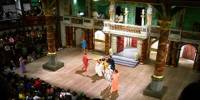To establish second Language Acquisition it is to be required some rules. It mainly focuses on learning and teaching. The terms ‘learning’ and ‘teaching’ play the important role in Second Language Acquisition.
Second Language acquisition deals with the learner and teacher. It focuses on the system which the teacher should follow in teaching and which the learner should follow in learning. In which way the teacher teaches and in which way the learner second Language.
As English is our second language so the second Language Acquisition deals with the fact as English is a foreign Language. This Second Language Acquisition that means learning English Language relates the learner in acquisition. In Second Language acquisition there will be many barriers these barriers occur many problem in learning second Language.
Both the teaching system and learning system are surely involved in second Language Acquisition.
This second Language learning can be affected when classroom weather is not perfect. When the situation of the class room is not fevourable in second Language learning. How the classroom should be? This depends on the teachers and the learner/ If the teachers wish that he will teach in Grammar Translation Method and if another teacher wishes that he will teach in Audiolingual Method that will depend on the teacher.
In case of foreign Language learning the teacher role and the student role that means learner role because the second Language acquisition is teacher and learner based.
It is to be seen that the teacher uses Bangla Language in the class of English Language Learning or the teacher speaks in Bengoli with the learners in the classroom. The teacher is to be aware about the teaching in learning second Language. When the learners see that the teacher is using Bangla in teaching English Language, then the learners might think that they can also use Bangla in learning English Language.
They can think that slite using of Bangla doesn’t fact, but it does actually fact.
When the learners are habituated in speaking English, it will be easy for the learners to acquire second Language. Though Bangla is our mother tongue, we can not but use it. But we have to be careful about Bangla that – it is making complex or not in learning second Language. It may be like that – the learners are in a complex situation because of their using Bangla Language in learning English Language.
In this case the teacher’s role is more important. Because if the teacher does not use Bangla Language in the classroom – the learners will be inspired in learning English Language.
Such an approach to teacher preparation requires changes in the role of both learner teacher and teacher educator. The student teacher must adopt the role of autonomous learner and researcher, in addition to that of apprentice. The role of the teacher education is no longer simply that of trainer, he or she must guide the student teacher in the process of generating and testing hypothesis and in using the knowledge so acquired as a basis for further development.
It rejects the Philosophies of “teaching as a craft” or “teaching as common serve”, both of which deny the significance of the principles on which good teaching depends. The view of teacher development described here attempts instead to use theory to guide and illuminate the meaning of observation and practical experience. In short, the intent of second language teacher education must be to provide opportunities for the novice to acquire the skills and competencies of effective teachers and to discover the working rules that effective teachers use.
Classroom management refers to the ways in which student behaviour, movement and interaction during a lesson are organized and controlled by the teacher to enable teaching to take place most effectively. Good managerial skills on the part of the teacher underlie many of the aspects of active teaching in Rosenshine’s description. As noted previously, a category such as time – on – task is related to the teacher’s managerial skills. In a well – managed class, discipline problems are few, and learners are actively engaged in learning tasks and activities, this contributes to the motivational level and expectations for success that the teacher creats in the class. Evertson, Anderson, and Brophy found that it was possible to identify teachers with managerial problems in the first few days of the school year that such problems continued throughout the year, and the managerial skills were related to levels of student involvement.
A lesson reflects the concept of structuring when the teacher’s intentions are clear and instructional activities are sequenced according to a logic and structure that students can perceive.
Studies of lesson protocols indicate that sometimes neither the teacher nor the learners understood what the intentions of an activity were, why an activity occured when it did, what directions they were supposed to follow, or what the relationship between one activity and another was, hence, it may not have been clear what students needed to focus on the complete a task successfully.
One interpretation of the development of second language teaching in the last twenty years or so is that a substantial degree of professionalization has taken place. Thus, the theoretical basis of the filed has moved from the study of phonetics and grammatical theory – once considered a necessary (and sometimes sufficient) basis to launch a student into a career as a language teacher – to include the study of pedagogical grammar, discourse analysis, second language acquisition, classroom-based research, inter-language syllabus design, and language testing.
Language teaching has achieved a sense of autonomy, with its own knowledge base, paradigms, and research agenda. Yet if a primary goal of graduate teacher preparation programs is die-preparation of effective language teachers, this claim to professionalism may be misplaced.
While there has been an expansion of the theoretical concepts, research issues, and subject-matter content which constitute much of the field, few who are engaged in developing this knowledge base or research agenda would claim any direct relation between their work and the preparation of language teachers. Research or theory that deals with the nature of second language teaching per sc is scant in the professional literature. While there is a body of practice in second language teacher education — based almost exclusively on intuition and common sense — until recently there has been little systematic study of second language acquisition.
Activities and learning experiences in the first domain — the micro- p perspective — reflect the training view of teacher preparation: Teaching of is broken down into discrete and trainnble skills, such as setting up, small-group activities, using strategies for correcting pronunciation classroom, using referential questions, monitoring time-on-task, explaining for meanings of new words, or organizing practice work. Training experiences that can his provided for the novice teacher include the following: I”
- Teaching assistantships – assisting an experienced teacher in aspects | of a class, such as using classroom aids or administering tests
- Simulations — participating in simulated classroom events, for example, to develop the ability to handle discipline and management r problems
- Tutorials – working as a tutor, for example, in a writing laboratory, to gain experience in the use of feedback techniques
- Workshops and minicourses-participating in training sessions focusing on specific instructional techniques, such as use of wait-time ?
- Microteaching – presenting structured mini-lessons using specific? strategies and techniques
- Case studies – observing films or videos in which desired teaching strategies and behaviors are demonstrated.
Activities in the second domain – the microperspective – reflect a view of teacher preparation as education and focus on clarifying and elucidating the concepts and thinking processes that guide the effective second language teacher. Activities and experiences are needed that help the novice teacher understand and acquire the means by which the effective teacher arrives at significant instructional decisions. Learning experiences include the following:
- Practice teaching – participating in a variety of practice teaching experience? that arc closely supervised by a skilled teacher.
- Observation — observing experienced teachers in a focused way and then exploring with the teacher, in a follow-up session, why things happened as they did and attempting to determine the kinds of conscious or unconscious decision making that guided the teacher.
- Self- and peer observation — reflecting on self- and peer performance in actual teaching situations, through audio or video recordings, in order to gain a deeper awareness of the processes and principles being employed
- Seminars and discussion activities — reflecting on the degree to which one’s own experience as a student teacher relates to»theory and to the findings of relevant research.
These and other activities are discussed in Chapters 2 and 3, and also in Part V.
Such an approach to teacher preparation requires changes in the role of both student teacher and teacher educator. The student teacher must adopt the role of autonomous learner and researcher, in addition to that of apprentice. The role of the teacher educator is no longer simply that of trainer; he or she must guide the student teacher in the process of generating and testing hypotheses and in using the knowledge so acquired as a basis for further development.
This approach rejects the philosophies of “teaching as a craft” or “teaching as common sense,” both of which deny the significance of the principles on which good teaching depends. The view of teacher development described here attempts instead to use theory to guide and illuminate the meaning of observation and practical experience. In short, the intent of second-language teacher education must be to provide opportunities for the novice to acquire the skills and competencies of effective teachers and to discover the working rules that effective teachers use.
This approach to the study of teaching – often termed direct, or active, teaching (the latter term is used here, since the term direct teaching has also been used in connection with the DISTAR program [Carnine and Silbert 1978], which treats only low-inference behaviors), is based on studies of effective teachers of content subjects, particularly at the elementary level. However, there is also evidence that the notion can be applied to certain kinds of second language settings as well (Tikunoff 1983). Rosenshine (1979: 38) describes active teaching as follows:
Direct instruction refers to academically focused, teacher-directed classrooms using sequenced and structured materials. It refers to teaching activities where goals are clear to students, time allocated for instruction is sufficient and continuous, coverage of content is extensive, performance of students is monitored, questions are at a low cognitive level so that students can produce many correct responses, and feedback to students is immediate and academically oriented. In direct instruction the teacher controls instructional goals, chooses materials appropriate for the student’s ability, and paces instructional episodes. Interaction is characterized as structured, but not authoritarian. Learning takes place in a convivial academic atmosphere. The goal is K> move the students through a sequenced set of materials or tasks. Such materials are common across classrooms and have a relatively strong congruence with the tasks on achievement tests. Thus, we are limiting the term “direct instruction” to didactic ends, that is, towards rational, specific, analytic goals.
According to the theory of active teaching, several dimensions of teaching account for the differences between effective and ineffective instruction (Doyle 1977, Good 1979). These include classroom management, structuring, tasks, and grouping.
Classroom management refers to the ways in which student behavior, movement, aricTTnteraction during a lesson are organized and controlled by the teacher to enable teaching to take place most effectively. Good managerial skills on the part of the teacher underlie many of the aspects of active teaching in Rosenshine’s description. As noted previously, a category such as time-on-task is related to the teacher’s managerial skills.
In a well-managed class, discipline problems are few, and learners are actively engaged in learning tasks and activities-, this contributes to the motivational level and expectations for success that the teacher creates in the class. Evertson, Anderson, and Brophy (1978) found that it was possible to identify teachers with managerial problems in the first few days of the school year, that such problems continued throughout the year, and that managerial skills were related to levels of student involvement.
A lesson reflects the concept of Mructunng when the teacher’s intentions are clear and instructional activities are sequenced according to a logic and structure that students can perceive. Studies of lesson protocols indicate that sometimes neither the teacher nor the learners understood what the intentions of an activity were, why an activity occurred when it did, what directions they were supposed to follow, or what the relationship between one activity and another was (Tikunoff, Berliner, and Rist 1975); hence, it may not have bee clear what students needed to focus on to complete a task successful.
Fisher et al. (1980: 26) conclude that students “pay attention more when the teacher spends time discussing the goals or structures of the lesson and/or giving directions about what the students are to do.” Berliner (1984: 63) like vise suggests that “structuring affects attention and success rate: It is sometimes not done at all, sometimes it is done only minimally, and sometimes it is overdone.”
Tasks, or activity structures, refer to activities that teachers assign to; attain particular learning objectives. For any given subject at any given 1 level, a teacher uses a limited repertoire of tasks which essentially defines; that teacher’s methodology of teaching (see Swaffar, Arens, and Morgan 1982).
These might include completing worksheets, reading aloud, dictation, quick writing, and memorizing dialogues. According to Tikunoff (1985), class tasks vary according to three types of demands they make on learners: response mode demands (the kind of skills they demand, such as knowledge, comprehension, application, analysis synthesis, eval-nation); international mode demands (the rules governing how classroom tasks are accomplished, such as individually, in a group, or with the help of the teacher); and task complexity demands (how difficult the I learner perceives the task to be).
Teachers have to make decisions not only about the appropriate kinds of tasks to assign to learners, but also about the order of tasks In what; sequence should tasks be introduced? pacing (How much time should learners spend on tasks?); products (Is the product or result of a task expected to be the same for all students?); learning strategies (What learning strategies will be recommended for particular tasks?); participation (Should all learners be assigned the same tasks?); and materials.
The concept of task has been central to studies of active teaching; as f noted earlier, the amount of time learners are actively engaged in academic tasks is directly related to achievement. Active teaching is thus I said to be task orientated. Effective teachers also monitor performance on I tasks, providing feedback on how wet tasks have been completed. A related dimension of active instruction is the grouping of learners f to carry out instructional tasks and the relation between grouping arrangement and achievement. An effective teacher understands how different kinds of groupings (such as seat work, pair work, discussion, reading circle, or lecture) camped or promote learning. Webb (1980) of found that in mixed-ability groups, the middle-ability child suffers a loss j of achievement he low-ability child shows some gains in achievement, compared with what would he expected if both were in uninformability groups. Tikunoff (1985) cites Good’s findings on groupings.
Good (1981) found that students in low-ability reading groups in the early grades received very little challenge, thus perceiving of themselves as being unable to read.
In addition, a long-range result of interacting most frequently with only other students of low-ability in such groups was an inability to respond to the demands of more complex instructional activities. Ironically, Good pointed out that the very strategy used to presumably help low-ability, youngsters with their reading problems – pull-out programs in which teachers worked with small groups of these students outside the regular classroom – exacerbated the problem. Demands in the special reading groups were very different from those in the regular classroom and at a much lower level of complexity, so low-ability students were not learning to respond to high level demands that would help them participate competently in their regular classrooms.
According to the theory of active teaching, effective instruction there— fore depends on factors such as time-on-task, question patterns, feedback, grouping and task decisions, as well as on factors such as classroom management and structuring. Some of these can be categorized as low- inference and others as high-inference categories. ;|
Although the concept of active teaching evolved from studies of content teaching, Tikunoff’s (1983) major study of effective teachers in; bilingual education programs has examined the extent to which the model can also be applied to other contexts.
Tikunoff suggests that three I kinds of competence are needed for the student of limited English proficiency (LEP): participative competence, the ability “to respond appropriately to class demands and to the procedural rules for accomplishing them” interactional competence, the ability “to respond both to; classroom fines of discourse and social rules of discourse, interacting appropriate with peers and adults while accomplishing class tasks”, and academic competence, the ability “to acquire new skills, assimilate new information, and construct new concepts”.
Furthermore, to be functionally proficient in the classroom, the student must be able to utilize these competences to perform three major functions:
a) to decode and understand both task expectations and new information;
b) to engage appropriately in completing tasks with high accuracy; and
c) to obtain accurate feedback with relation to completing tasks accurately.
In the Significant Bilingual Instructional Features descriptive study, Tikunoff (1983) collected data to find out how effective teachers in bilingual education programs organize instruction, structure teaching activities, and enhance student performance on tasks. Teachers were interviewed to determine their instructional philosophies, goals, and the demands they would structure into class tasks.
Teachers were clearly able to specify class task demands and intended outcomes and to indicate what LEP students had to do to be functionally proficient. Case studies of teachers were undertaken in which teachers were observed during instruction, with three observers collecting data for the teacher and for four target LEP students. Teachers were interviewed again after instruction.
An analysis of data across the case studies revealed a clear linkage between (1) teachers ability to clearly specify the intent of instruction, and a belief that students could achieve accuracy in instructional tasks, (2) the organization and delivery of instruction such that tasks and instructional demands reflected this intent, requiring intended student responses, and (3) the fidelity of student consequences with intended outcomes.
In other words, teachers were able to describe clearly what instruction would entail, to operationalize these specifications, and to produce the desired results in terms of student performance, Tikunoff’s (1983) findings confirm that the concept of active teaching can be used to account for effective teaching in bilingual education ; programs. These findings also suggest the value of extending this approach to the study of effective teaching to other kinds of language programs. What is the equivalent of active teaching in an on-arrival second Ianguage program, an advanced speaking class, or a secondary-level foreign language reading class? Once these questions have been answered, the issue arises of the application of the findings to teacher preparation.

















